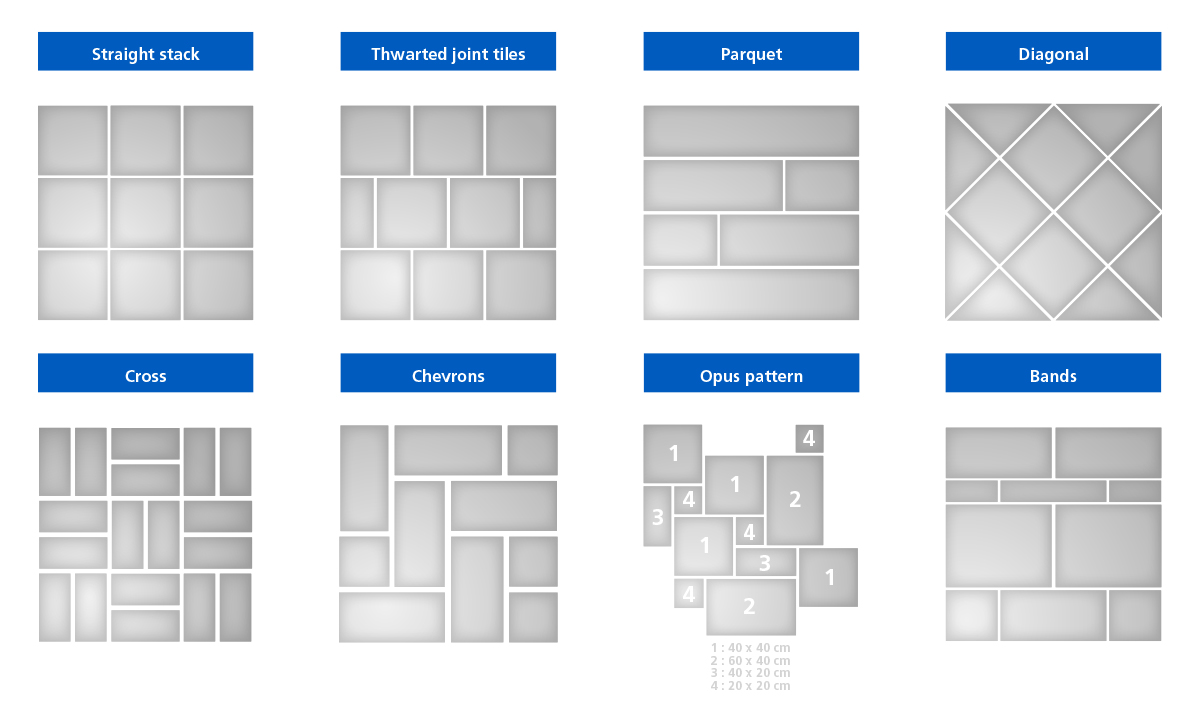POSER DU CARRELAGE : LES DIFFERENTES POSES
How are you going to lay your tiles?
Rather than looking in all directions, here are some examples ...
There are several ways to arrange your flooring:

Classic or straight stack
Also called full-bleed or «tape opus»,
this pose is very common because it is the easiest method to use especially if you get tiles of the same size.
They are aligned at right angles from one wall to the opposite wall.
It is recommended to use this method with largest tiles
With thwarted joint tiles
Or «shifted» pose.
Each row of tiles is offset by half of the previous one (if using square format tiles)
or a third (if you want to lay rectangular tiles).
Parquet or eherringbone
This method is used to create a decorative pattern, most often used with rectangular tiles with imitation wood effect.
You can also arrange the tiles in broken sticks: the tiles are arranged one after the other with a blade in one direction and the other placed perpendicularly.
Diagonal
This «oblique» pose is also very common.
The first tile is placed in the center of the room and will be used as a guide for all other tiles.
This method makes it possible to hide the imperfections of a room (asymmetry, uneven walls).
It gives the feeling of virtual enlargement of the room
Multiformat or «opus pattern»
This process uses tiles of different sizes to create random patterns.
This method gives a varied and pleasant appearance;
however, rigor is required during the layout
because the placement of the tiles is very precise and must be numbered.
The set is made with 4 types of tiles that form a repeating pattern.
There are still many ways to lay the tiles, such as:
- The pose with cabochons
(small tiles of different colors are placed at the corners of classic tiles)
- The checkered pattern
- Carpet laying
(The tiles concerned are chosen to delimit an area or to highlight an architectural element, different color or size to represent a «carpet»)
Determine the numer of tiles
First you need to measure the dimensions of the room to be tiled, in square meters.
You can draw a diagram of the room to scale, which will allow you to easily plan the laying of the tiles.
Calculate the area of ??a tile in m2, then divide the area of ??the room (in m2) by the area of ??a tile (in m2), you will get the number of tiles you need.
However, keep a safety margin by buying 15% of additional tiles for the cutouts and to alleviate the problems of breakage or defective tiles (breakage in the cardboard, different color, scratches, etc.)
If you are planning to make a particular pattern, consider drawing a diagram on paper and numbering the tiles, or even put them in color on your diagram, in order to avoid mistakes.
Now that you have chosen how to lay your tiles, it’s time for preparation and especially to «lay out»!



